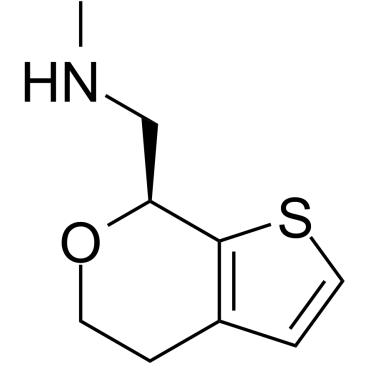1310426-33-5
| Name | SEP-363856 |
|---|
| Description | SEP-363856 (SEP-856), an orally active and CNS active psychotropic agent with a unique, non-D2/5-HT2A mechanism of action, exerts its antipsychotic-like effects. SEP-363856 (SEP-856) has the potential for the treatment of schizophrenia[1]. |
|---|---|
| Related Catalog | |
| Target |
TAAR1:0.140 μM (EC50) 5-HT1A Receptor:2.3 μM (EC50) 5-HT1B Receptor:15.6 μM (EC50) 5-HT1D Receptor:0.262 μM (EC50) 5-HT2A Receptor:>10 μM (EC50) 5-HT2C Receptor:30 μM (EC50) 5-HT7 Receptor:6.7 μM (EC50) |
| In Vitro | SEP-856 (10 μM) shows >50% inhibition of specific binding at α2A, α2B, D2, 5-HT1A, 5-HT1B, 5-HT1D, 5-HT2A, 5-HT2B, 5-HT2C, and 5-HT7 receptors[1]. |
| In Vivo | SEP-856 (0.3, 1 and 10 mg/kg, i.p.) is CNS active and exhibits a behavioral signature similar to known antipsychotic drugs[1]. SEP-856 (0.3, 1 and 10 mg/kg, orally once) significantly reduces PCP-induced hyperactivity[1]. Oral SEP-856 administration (1, 3 and 10 mg/kg) produces a dosedependent decrease in REM sleep, increase in latency to REM sleep and increase in cumulative wake (W) time[1]. Animal Model: Acute treatment with phencyclidine (PCP), which induces robust hyperactivity in rodents[1]. Dosage: 0.3, 1 and 3 mg/kg. Administration: Orally once. Result: Resulted in a dose-dependent inhibition of PCP-induced hyperactivity responses in C57Bl/6J mice (1-way ANOVA F (5, 59) = 18.96, p < 0.0001; Tukey’s post-hoc test, p < 0.05) with a 50% effective dose (ED50) of approximately 0.3 mg/kg. Animal Model: Male Sprague Dawley rats[1]. Dosage: 1, 2, and 5 mg/kg. Administration: I.V. injection. (Pharmacokinetic Analysis). Result: 0.5 hours in mice and rats and maximum plasma concentrations reached within 6 ± 2.83 hours in monkeys. Penetrated mouse and rat brains after oral administration (10 mg/kg), with average brain-to-plasma AUC ratios of ~3 respectively. |
| References |
| Molecular Formula | C9H13NOS |
|---|---|
| Molecular Weight | 183.27 |
